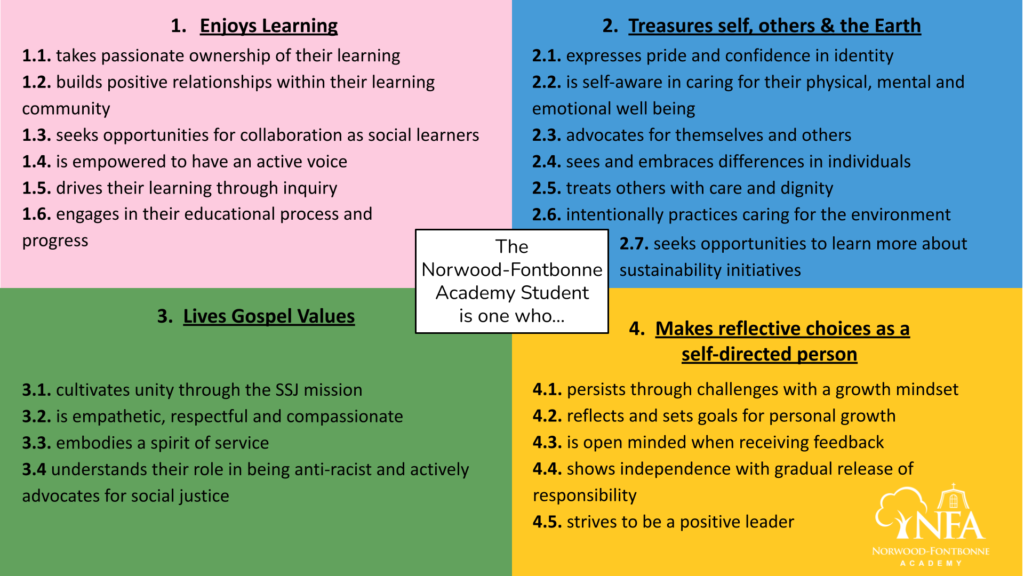The Norwood-Fontbonne Academy student is one who enjoys learning, treasures self, others, and the earth, lives Gospel values, and makes reflective choices as a self-directed person.
Norwood-Fontbonne Academy is a Catholic, independent academy for preschool – eighth-grade students in nearby Chestnut Hill. NFA offers a dual academic path in Montessori or Primary for students age 3 – 3rd grade.
During the summer of 2020, following an extremely challenging, yet inspiring, spring semester impacted by the COVID-19 pandemic, Norwood-Fontbonne Academy’s Curriculum Council members could have put their work on pause, but instead, because of of their sincere belief in the school’s student vision statement, they decided to spend their free time further developing it.
The NFA student is one who…
Enjoys Learning
Treasures self, others, and the earth
Lives Gospel values
Makes reflective choices as a self-directed person.
The faculty at NFA truly believe the student vision statement defines every NFA student and extends itself to all NFA community members. Reflective of the mission of NFA’s founders, the Sisters of St. Joseph, NFA teachers and administrators have used the vision statement as their north star for many years now in planning engaging learning experiences for students. The statement dates back to the 1997-98 school year, but was refined to become the gold standard it is now when the Curriculum Council was formed in 2020.
“This was at the height of the pandemic, and the council had a big task at hand: to prepare teachers for returning to a completely different landscape in the classroom for the next school year,” said Shannon Craige, Director of Curriculum and Innovation. “The NFA teaching staff grew as a community of learners when we were virtual in the spring of 2020, and this was a chance to reset and remember the WHY behind what we do. The WHY is our students. We knew this was a great opportunity to focus on our students to drive our preparations for the new school year.”
Through their diligence and perseverance, the Curriculum Council – Craige, Marianne Canuso (4th Grade), Abby Montler (2nd Grade), Joe Rosowski (Middle School Math), and Dr. Monica Walsh (Montessori Preschool) – led the NFA teaching staff in an “unpacking” of the four components of the vision statement.
“We took a closer look at what it means for our students to truly live the vision statement,” said Craige. “We gathered input and further broke down each component into specific indicators that identify what it looks like when students embody the vision statement. It’s a way to understand the vision statement in action. This is the portrait of an NFA student.”

For the past two years, the Curriculum Council has built in many intentional routines for teachers and students to align their daily practices with the vision statement indicators. Teachers are guided to design learning experiences that align with the indicators appropriate for their grade level.
“When planning lessons, we keep in mind questions such as, ‘How can I create opportunities for my students to make reflective choices?,” said Montler. “Because we give students these expectations, we find it important to also give them the opportunity to practice them.”
The vision statement has become a fluent language used among the teachers and students. Classrooms have incorporated the vision statement into their daily routines. Students are prompted to reflect on oneself in alignment with the indicators. Canuso shares about a daily fourth grade practice that sets the tone for each student and their classroom community as a whole,
“We begin the school day using the vision statement as a guided meditation,” said Canuso. “Students reflect on questions such as, ‘How will I treat others with care and dignity today?’ and ‘How will I strive to be a positive leader today?’ Our hope is for each student to envision themselves intentionally living out the NFA vision each and every day.”
There are also specific times of the school year that call for deeper reflection and goal setting, and now teachers are able to use the vision statement indicators to anchor those reflective exercises with one commonality across the whole student body. Not only can students measure their progress with the indicators as a guide, they are also provided the opportunity to show evidence of their growth.
“A specific use of making reflective choices is applied during our student-led conferences,” said Walsh. “Within a trimester, students evaluate their learning progress, learning style, learning interests, challenges, and areas of growth. With the support of their teacher, students share these reflections with parents. Applied use of self reflection creates a culture which encourages purpose and potential.”
Another example of how students measure their progress is through frequent goal setting, aligned with the vision statement indicators.
“Throughout the school year, students get the opportunity to create goals for themselves based on the vision statement,” said Rosowski. “Being prompted to go through these reflective exercises, students get to think deeper about their personal goals. This allows students to foster their identity as an NFA student, and something we believe they will carry with them into high school and beyond.”
Register for an upcoming open house to learn more about Norwood-Fontbonne Academy.

